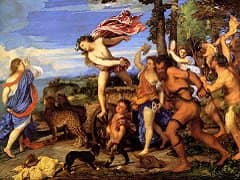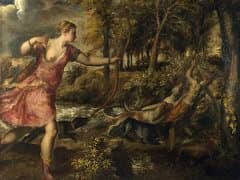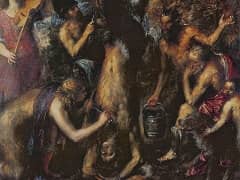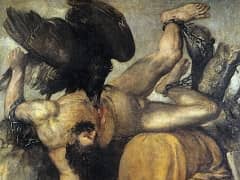Danae, 1545 by Titian

Danae, ravished by Jupiter in the form of a shower of gold, initiates the long series of Ovidian interpretations that occupied much of the latter part of Titian's career. Painted for Alessandro Farnese during the artist's stay in Rome, the painting must have developed under conditions of highly self-conscious competition with Roman art - ancient and modern - and especially with the works of Michelangelo, whose own pictorial composition o(Leda and the Swan may have sounded a specific challenge to which Titian was responding. According to Vasari, Michelangelo criticized Titian's work for its supposed lack of disegno, but the Danae is indeed a deliberate demonstration of Venetian colorito; its unifying tonalism and controlled coloring create that environmental illusion that defies sculptural discreteness - a sine qua non of the Central Italian aesthetic - even as it invites, by suggestion, tactile exploration.
The composition is carefully stabilized by the horizontal and vertical of couch and column; against those coordinates the reclining Danae moves sinuously into a deeper space, her languid rhythms underscored by the serpentine activity of the bedclothes. Through its calculated twist, her body shifts from a profile position parallel to the picture plane to a more frontal presentation of her upper torso; the axis of that path continues along her neck, throwing her head back into shadow. At her feet Cupid moves contrapuntally in the opposite direction, emerging forward out of the darkness.
The scene is illuminated from the outside, but that natural lighting, describing the passive sensuality of Danae, fails to penetrate the sanctum of the dark middle ground. There the ominous cloud of Jupiter rains its potent treasure upon her receptive body, the subdued radiance of the coins glittering in the surrounding shadow. Drawn by that mystery into the darkness beyond the immediate sensual appeal of the quietly ecstatic heroine, we become involved in the miraculous form of the metamorphosed amorous deity. By the tangibility of his painted world, its sensuous rhetoric, Titian endows the myth with a palpable and convincing reality.















